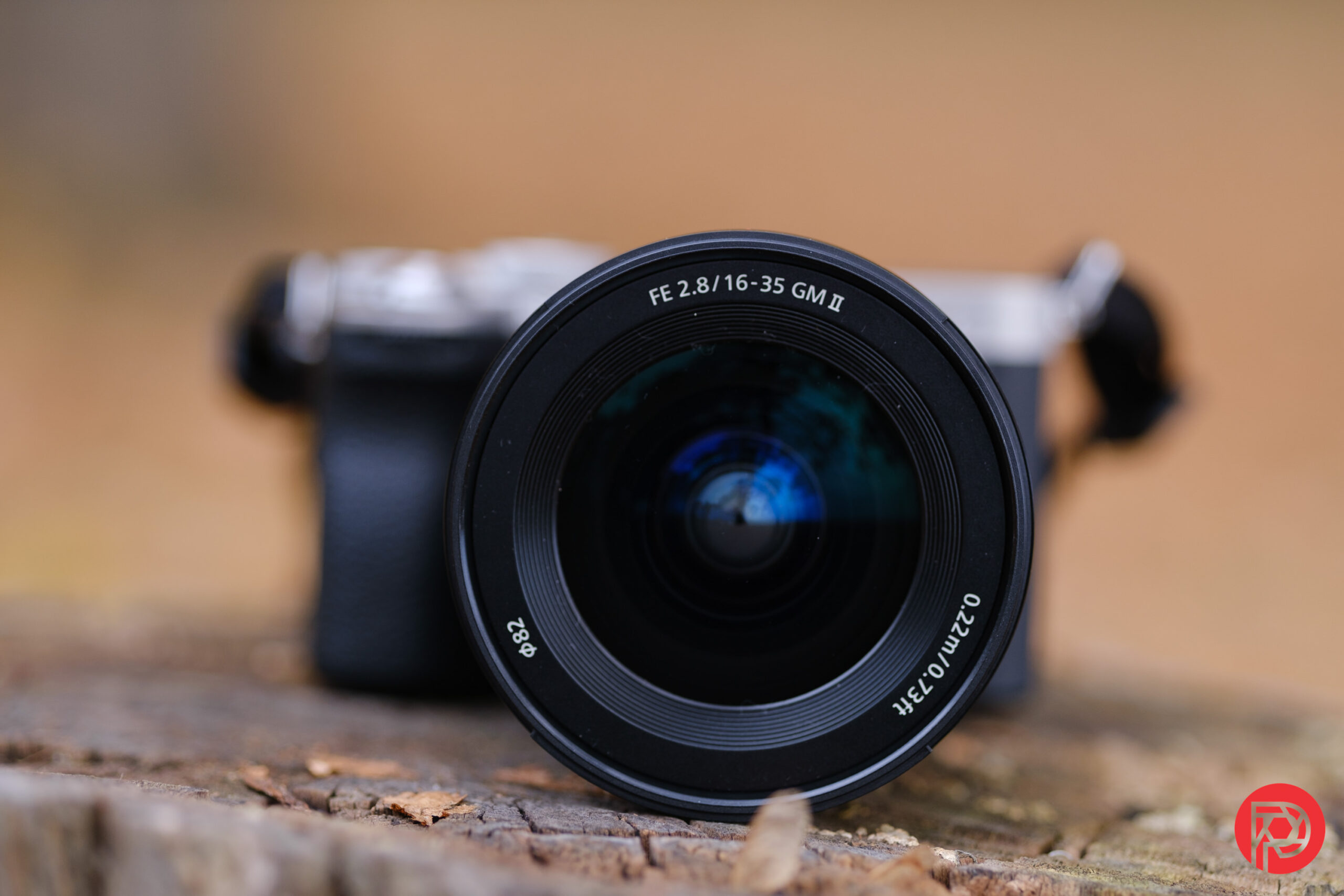Second-generation lens updates often feel fairly marginal, with a few minor tweaks. And with the Sony 16-35mm f2.8 GM already being a highly regarded lens, it wouldn’t be surprising if the update to that lens was pretty basic. But, that’s not exactly the case. The new Sony 16-35mm f2.8 GM II is a lighter version of the ultra-wide zoom, yet Sony has still managed to fit in a new aperture ring. The updated lens also focuses a bit closer than the original.
But, the second generation lens has some pretty big shoes to fill as the original scored top marks. Can the lens live up to the hype? I tested the Sony 16-35mm f2.8 GM II to see how the lens holds up.
Table of Contents
The Big Picture
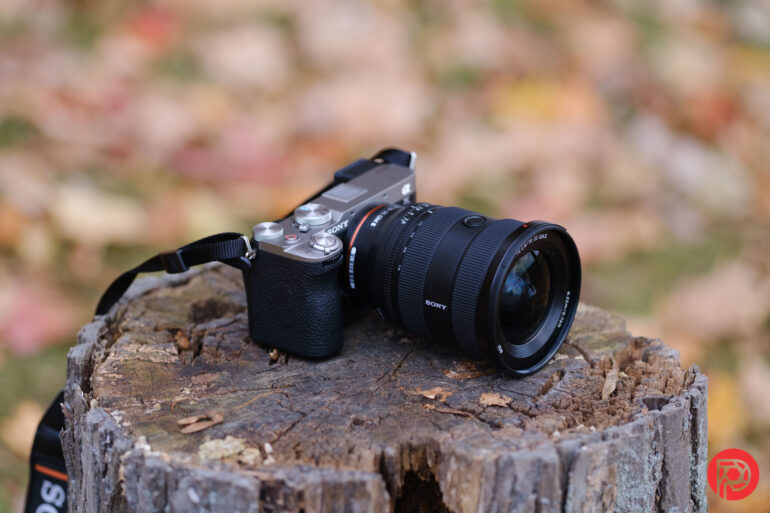
The Sony 16-35mm f2.8 GM II embodies everything that I come to expect from a Sony GM lens. All the things that most photographers universally hate — vignetting, barrel distortion, chromatic aberration — are well controlled, if they exist at all. The floating autofocus motor operates both quickly and quietly. One of the best changes from the original is that it can focus close enough for a 1:3.1 macro ratio. But, those updating the lens will also find the lighter weight refreshing.
The Sony 16-35mm f2.8 GM II met and even exceeded some expectations. But, it doesn’t render much lens flare, which is excellent if you want near scientific accuracy but doesn’t bode as well for character. And while most bokeh is stunning, occasionally, the brightest artificial lights will take on more of a soap bubble texture. Like other f2.8 zooms, the lens is pricey and should be considered a long-term investment. The lighter build also means the materials on the lens barrel don’t feel quite as nice. Still, those are minor qualms for some pretty stunning images.
I’m giving the Sony 16-35mm f2.8 GM II five out of five stars.
Want one? Check it out on Amazon.
Pros
- Lightweight and compact
- A new aperture ring with declick!
- Nice and sharp
- Bokeh is round and doesn’t take on much cat-eye shape towards the edges
- Focuses as close as .7 feet
- Autofocus has decent speed and is pretty quiet
- Great image quality that’s pretty consistent with other GM series lenses
- Minimal, if non-existent, distortion, aberration, and vignetting
- Stabilized
- Weather-sealed
Cons
- Occasional soap bubbling to the bokeh
- Flare is heavily suppressed
- The lighter build doesn’t feel quite as nice
Gear Used
I tested the Sony 16-35mm f2.8 GM II with the Sony a7c II. Both the lens and camera were temporary loans from Sony and LensRentals.
Innovations
The Sony 16-35mm f2.8 GM II has a lot to live up to, as the original was a highly-ranked, impressive lens designed to pair with the standard 24-70 and 70-200mm f2.8 lenses. While the original is great, the lens with the II in the name isn’t just a minor refresh. The second-generation lens is around 20 percent lighter as well as a bit shorter. Despite that, the new lens has an aperture ring, complete with a declick switch. Besides the design changes, the new lens also focuses a bit closer than the original.
Ergonomics
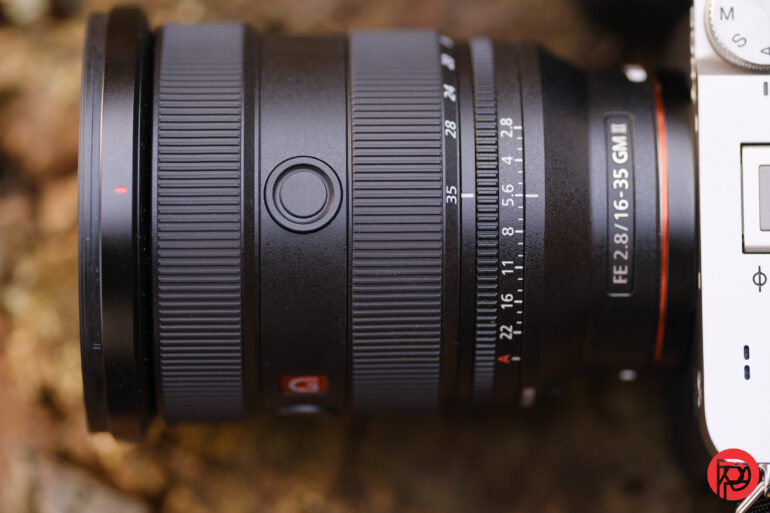
Ultra-wides tend to be bulky, and ultra-wides with both zoom and an f2.8 aperture are especially so. But, the Sony 16-35mm f2.8 GM II is reasonably sized — in fact, at its launch, Sony said it’s the lightest of its kind among other full-frame autofocus lenses with the same focal lengths. The lens weighs 1.2 pounds. It’s not a terribly heavy lens to carry around for long stretches. The lens will take up a 4.4-inch slot in a camera bag.
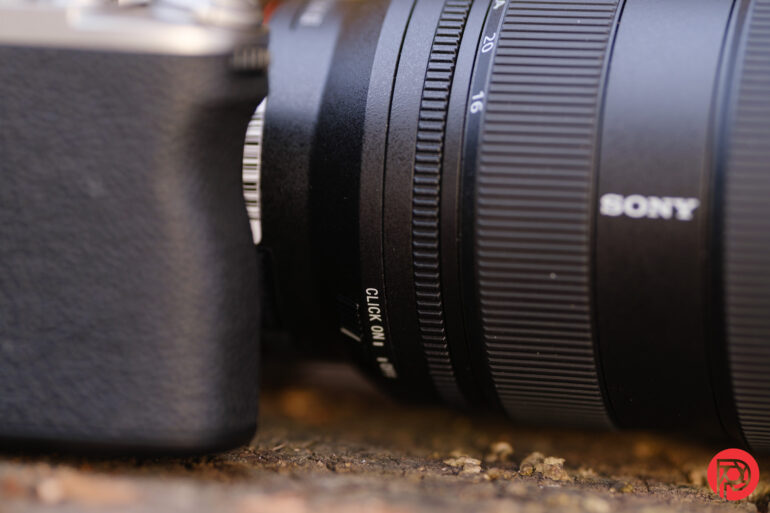
The addition of a dedicated aperture ring is a lovely update, allowing for quick aperture changes right on the barrel. An iris lock switch locks the lens in the A position or alternatively prevents the lens from turning off manual settings into auto. Videographers can use the declick switch for smooth aperture adjustments without the click.
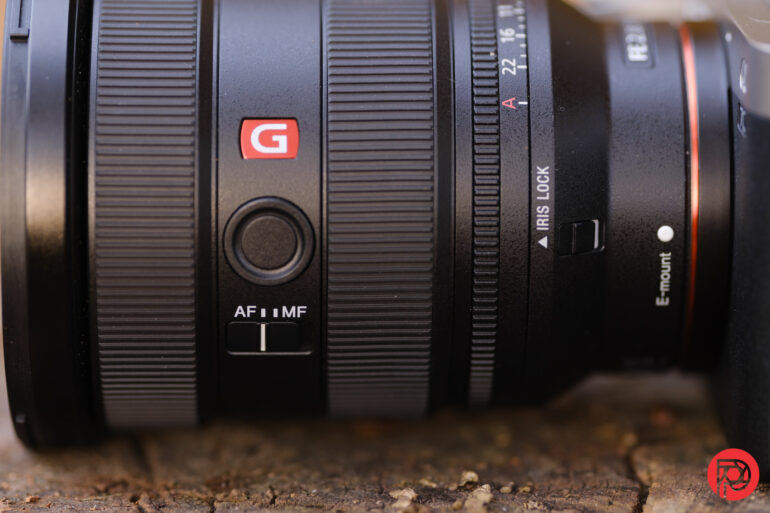
Moving further from the mount, the next control is a grippy zoom ring. The space between that ring and the focus ring at the front houses custom buttons and an AF-MF switch.
The front of the lens accepts 82mm filters. It ships with a petal-shaped lens hood.
Build Quality
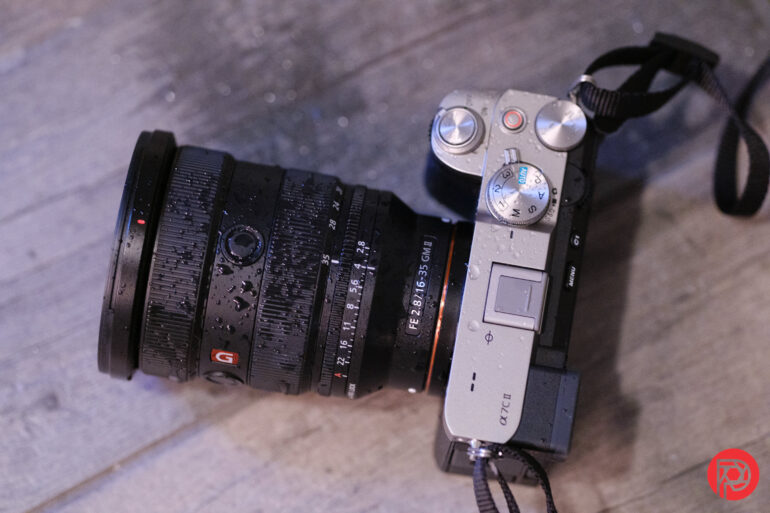
I love the portability of the Sony 16-35mm f2.8 II lens. But, the barrel has a bit of a plasticky feel. It’s not terrible, but I’ve held nicer feeling GM lenses. I suspect this is where some of the weight savings come in.
While the barrel is plastic, the lens is weather-sealed. I gave the lens a good splash from the sink and did not experience any ill effects. By the end of the review, I hadn’t spotted any dust or debris on the camera sensor or inside the lens mount.
Focusing

The Sony 16-35mm f2.8 GM II can focus as close as .7 feet from the front of the lens. While that’s far from macro standards—1:3.1 to be exact—it’s pretty solid for an ultra-wide zoom. Getting in close will really play up the bokeh as well as the perspective distortion of the wider focal lengths.
The lens was fast enough to get plenty of keepers when photographing lifestyle images of kids running around. It also kept up with a dog running straight towards the camera pretty well. The lens had a few misses in these fast-paced scenarios but still nailed a majority of the shots. I suspect some of those misses had to do with using one of the more affordable E-Mount body, the a7C II, for testing.
There weren’t really any autofocus surprises here — the lens focused like I would expect an ultra-wide to focus. It locked on fast enough to have a high, though not perfect, hit rate for action, with the best results coming with eye detection, turned on. The lens’ autofocus motors also operate fairly quietly as well.
Ease of Use

The stabilization in the Sony 16-35mm f2.8 GM mixed with the ultra-wide angle makes it possible to capture some handheld long exposures. I had a pretty good hit rate of sharp shots at half a second. And while the hit rate was much lower, I did manage to get a few sharp images at up to 2.5 seconds long.
The stabilization mixed with the updated design makes this lens a joy to use. I much prefer adjusting the aperture right on the lens, so I love the new aperture ring. The added ring makes the lens easier to use for experienced shooters. But, for newer photographers, it is possible to lock the lens in the auto position, so I think the lens is suited for a range of different abilities.
Image Quality

The Sony 16-35mm f2.8 GM II lived up to the high expectations I had for this lens. And because the lens fell right in with what I would expect from a Sony GM, the images should work well with the other lenses in the trilogy, the 24-70 and 70-200mm, with fairly consistent color and sharpness across albums shot with different lenses.
Like most other Sony GM lenses, this lens is more technically superb than a unique character builder. The close focusing distance, wide views, and bright aperture work really well together at creating some fun images, however. And even pixel peepers are going to be happy with the sharpness.
Bokeh
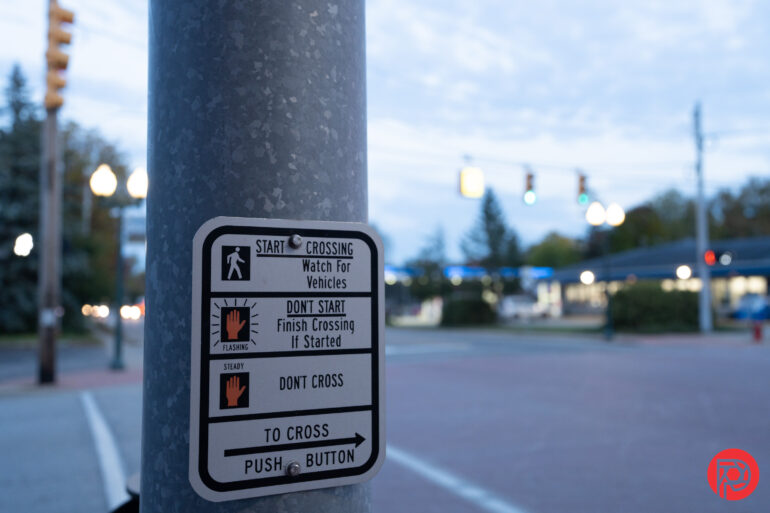
The wide aperture and ability to get in close makes up for the shorter focal length. Bokeh is still more than just possible but rather easy to create, with the best results coming from getting in close at f2.8. Combined with the sharpness of the lens, the subject really stands out.
Points of light are rendered towards smooth bokeh balls that, even at the edges, stay round rather than cat-eye. Most bokeh balls had smooth edges. Occasionally, with stronger points of light, such as streetlights on a dark night, the bokeh took on a slightly soapy texture, but not often.
Color Rendition

The colors had just the right amount of pop to them without being overly saturated. I found the colors coming from the Sony 16-35mm f2.8 GM II to be very consistent with the other Sony lenses that I’ve used. That means that, in post, I would expect edits to sync up nicely across multiple GM series lenses. When shooting on green grass, I wanted to tone down the greens in post, along with warming up the skin tones. Because flare is heavily suppressed, the lens doesn’t wash out colors as much as others when shooting in backlight.
Lens Character

The coatings on this lens help suppress flare, which is great for color consistency but not so great if you actually want a bit of sun flare in your shots. Much of the character coming from this lens stems simply from the ultra-wide view mixed with the wide aperture and close focusing distance. The perspective of a wide-angle lens, when you get in close to the subject, creates an almost whimsical feel in portraits.
For landscapes, the wide view is impressively low on barrel distortion, and it’s reasonably easy to keep lines straight. Flipping back and forth between the JPEG and RAW files, which typically makes these distortions stick out, there wasn’t any noticeable difference in those lines. That means that the barrel distortion correction is all in the lens, not the lens profile that’s edited and applied to the image. Similarly, I also didn’t notice any strong vignettes. At 35mm, you can get some nice, perfectly straight horizons and buildings. At 16mm, you have to hold the camera just so as to avoid—or intentionally create—perspective distortion.
Sharpness

I didn’t need to touch the sharpness slider during post-production at all with this lens. Then again, as a Sony GM, that’s hardly surprising. Images are sharp down to eyelash level, which lends to some very detailed images and subjects that really pop.
Extra Image Samples
From day one, The Phoblographer has been huge on transparency with our audience. Nothing from this review is sponsored. Further, lots of folks will post reviews and show lots of editing in the photos. The problem then becomes that anyone and everyone can do the same thing. They’re not showing what the lens can do. So we have a section in our Extra Image Samples area to show edited and unedited photos. From this, you can make a decision for yourself.
Unedited





















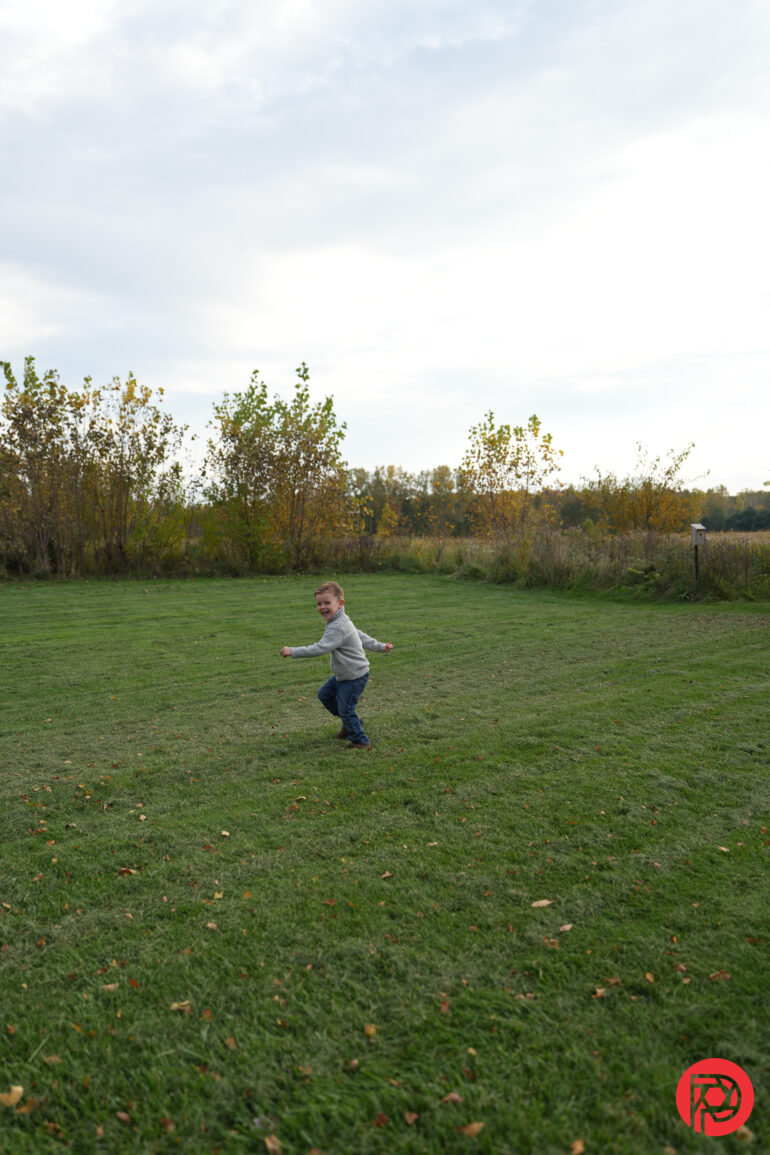


Edited




























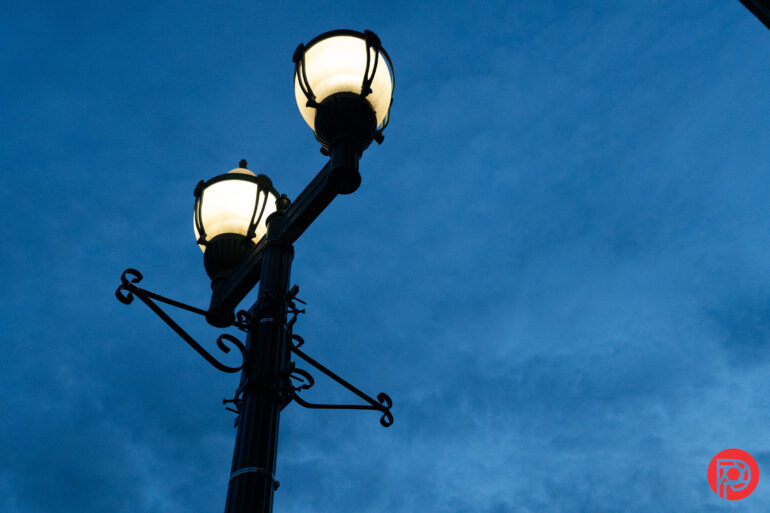
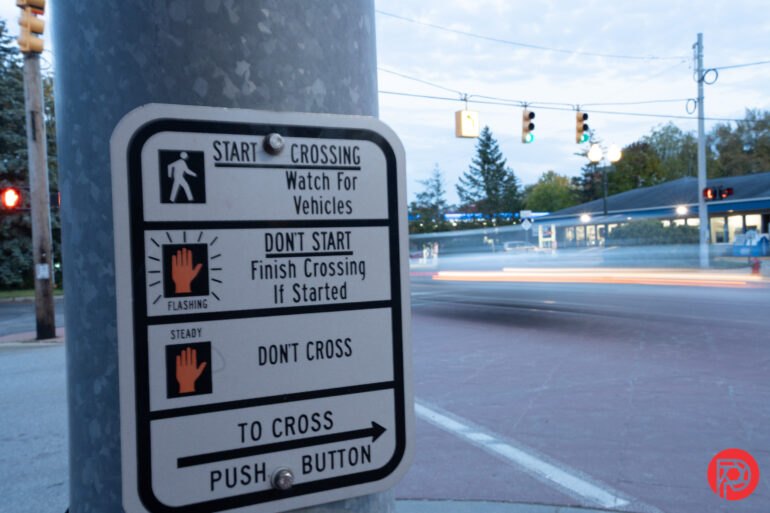




Who Should Buy It?
Sony E-Mount shooters that want fast focus, sharp subjects, and minimal barrel distortion should consider investing in the Sony 16-35mm f2.8 GM II. The lens renders some gorgeous wide-angle shots. It’s a superb piece of technology when it comes to fighting all the cringy glitches like colored fringing and curving horizons. The lighter weight over the original will also be a welcome change for photographers that wear this lens for long stretches, as well as for traveling.
But if you love shooting towards the sun to create flare, then this isn’t the lens for you. But, dare I say it, Sony probably isn’t the right brand for flare lovers.
Should photographers with the previous lens upgrade? I don’t believe Sony touched much when it comes to image quality — the original was already impressively sharp. But the aperture ring, lighter design, and closer focusing capabilities are really lovely. The question is, are those changes lovely enough for the $2,300 list price?
Tech Specs
LensRentals lists the following tech specs for the Sony 16-35mm f2.8 GM II:
- Angle of View: 107° to 63°
- Aperture Blades: 11, Rounded
- Autofocus: Autofocus
- Brand: Sony
- Compatibility: Full Frame
- Filter Size: 82.0mm
- Focal Length: 16.0-35.0
- Dimensions (ø x L): 3.5 × 4.4″ / 87.8 × 111.5mm
- Weight: 1.2 lb. / 547 g
- Hood Included: Yes
- Image Stabilization: Yes
- Item Type: Lens
- Lens Type: Wide Angle
- Max Aperture: 2.8
- Maximum Magnification: 0.32x
- Mfr. Model Number: SEL1635GM2
- Minimum Aperture: 22.0
- Minimum Focusing Distance: 0.7 feet
- Mount: Sony E
- Groups/Elements: 12/15
- Aspherical Elements: 5
- Extra-Low Dispersion Elements: 2
The Phoblographer may receive affiliate compensation for products purchased using links in this blog posted.
